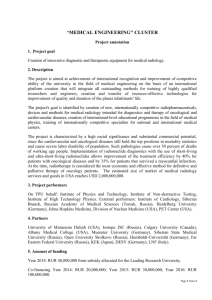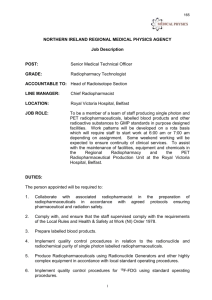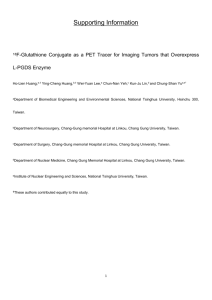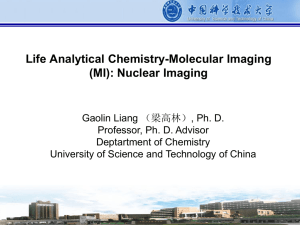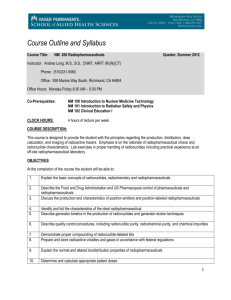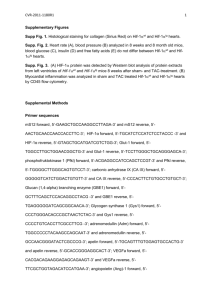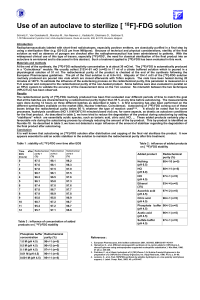Radiopharmaceuticals
advertisement
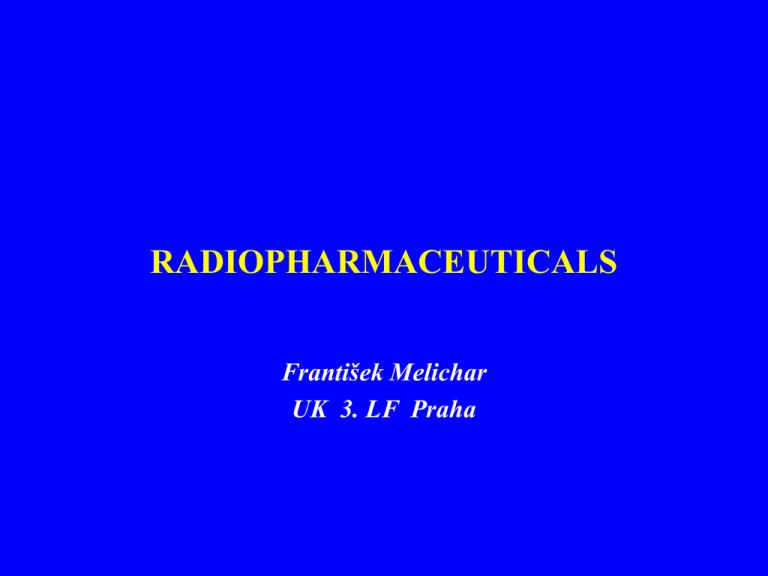
RADIOPHARMACEUTICALS František Melichar UK 3. LF Praha František Melichar Radiopharmaceuticals Scope of Presentation • Basic information • Diagnostic radiopharmaceuticals • – SPECT, – PET Therapeutic radiopharmaceuticals – palliative radiopharmaceuitcals – Immunotherapeutic radiopharmaceuticals – radiation synovectomy Radiopharmaceuticals A radiopharmaceutical is a radioactive compound used for the diagnosis and therapeutic treatment of human diseases Radiofarmaceuticals Has two components : •radionuclide •pharmaceutical proteins, Mab, inorganic, organic compounds Radiopharmaceuticals designing First chosen is on basis of its preferential localization in given organ or its participation in the physiologic function of the organ Radiopharmaceuticals Difference between radiochemicals and radiopharmaceuticals Ideal radiopharmaceutical •Easy availability •Shorf effective Half-Life •Particle Emission •Decay by Electron Capture or Isomeric Transition •High Target-to Nontarget Activity Ratio Radiopharmaceuticals Radioactive element - 133Xe Labeled compounds - 131I iodinated proteins 99mTc labeled compounds [18F]FDG Radiopharmaceuticals Radiopharmaceuticals usually have no pharmacologic effect, because in most cases they are used in trace quantities Differ from conventional drugs but they should be sterile and pyrogen free Easy availability (1) Nuclear reactor (n,p), (n,) A X (n,) A+1 X Z Z 98Mo (n,) 99Mo 99mTc Particle accelerators 68Zn (p,2n) 67Ga 203Tl (p,3n) 201Pb +or EC 201Tl Easy availability (2) Starting material and product have diferent chemical identities Enriched target Secondary source Generator of radionuclides 99Mo/99mTc, 113Sn/113mIn, 81Rb/81mKr,82Sr/82Rb, 90Sr/90Y,68Ge/68Ga Short Effective Half-Life Physical half-life TP , t1/2 p=0,693/Tp - decay constant Biologic half-life Tb b=0,693/Tb Effective half-life Te e= p+ b 1/Te=1/Tp +1/Tb Particle Emission Diagnostic purpose -undesirable Therapeutic purpose - , Radiation damage of abnormal cells High Target-to Nontarget Activity Ratio To provide maximum efficacy in the diagnosis (therapy) and minimum radiation dose to the patient Factors Influencing the Design of New Radiopharmaceuticals (1) Compatibility-incorporation radionuclide into the molecule 111In-DTPA Stechiometry- concentration 99mTc approx. 10-9 mol/l Charge of the Molecule Size of Molecule Factors Influencing the Design of New Radiopharmaceuticals (2) Protein Binding Solubility Stability Biodistribution Type of radiopharmaceutical for diagnostic and therapy • Parenteral pharmaceuticals (solutions or colloid suspenses), • peroral pharmaceuticals • inhalation pharmaceuticals • topic pharmaceuticals Radionuclide suitable for application in nuclear medicine H Li Na K Rb Cs Fr Be Přirozené radioaktivní prvky ( Mg Ca Sc Ti V Cr Mn Fe Co Ni Cu Sr Y Zr Nb Mo Tc Ru Rh Pd Ag Ba La Hf Ta W Re Os Ir Pt Au Ra Ac Rf Db Sg Bh Hs Mt B ) Al Zn Ga Cd In Hg Tl C Si Ge Sn Pb N P As Sb Bi O F S Cl Se Br Te I Po At He Ne Ar Kr Xe Rn Ce Pr Nd Pm Sm Eu Gd Tb Dy Ho Er Tm Yb Lu Th Pa U Np Pu Am Cm Bk Cf Es Fm Md No Lr 18F 99mTc 111In 67Ga 201Tl Technécium Indium Gálium Tálium Fluór 110 min - 140 keV - 171, 245 keV - 93, 184 keV - 167, 135 keV 6,0 h 2,8 d 3,26 d 3,04 d 131 I 153Sm 186Re Jód Samárium Rénium - 158 keV 8,02 d - 103 keV 46,7 h - 137 keV 3,78 d + Pozitronové zářiče Diagnostika Terapie © J.Lepej, ONM BB Slovakia Diagnostic radiopharmaceuticals for SPET 99mTc dominant radionuclide in the NM Radiofarmaceuticals precurzor source is radionuclide generator 99Mo (-,T =66,2 h) / 99mTc (IT,T =6,02 h) 1/2 1/2 Other radionuclides for labeling radiopharmaceuticals 201 Tl (EC, T = 72 h) , 67 Ga (EC, T 1/2 1/2 =77,9 h), 111 In (EC, T 123 I (EC, T 1/2 =2,8 d), 1/2 = 13,2 h), 125 I (EC, T 1/2 =60,1 d), 81Rb (EC, +, T = 4,57h, /81mKr(IT, T = 13 s) 1/2 1/2 Radionuclide generator 99Mo (-,T1/2=66,2 h) / 99mTc (IT,T1/2=6,02 hod) 99mTc-HMPAO 99mTc-ECD Na99mTcO4 99mTc-HIDA 99mTc-SESTAMIBI 99mTc-L,L-EC 99mTc-PEG liposomy 99mTc-Q12 99mTc-SCN 99mTc-IODIDA 99mTc-MAG 3 99mTc-(V)-DMSA 99mTc-(III)-DMSA 99mTc-anti-SSEA-1 99mTc-GH 99mTc-DTPA 99mTc-DPD 99mTc-MDP 99mTc-PYP 99mTc-EHDP 99mTc-DMPE 99mTc-citrát 99mTc-EDTMP 99mTc-MIBI Další… Sorption generator Diagnostic radiopharmaceuticals for PET Emission + , anihililation gama kvant 511 keV Cyclotron radionuclide preparation Biogen nuclide, short T/2, preparation( syntetisation automat), aseptic preparation , generator nuclide 124I, 86 Y intravenose aplication Positron (+) radiation - annihilation 1. a proton inside the 18F nucleus turns to a neutron while a positron (+) and a neutrino are emitted n + + + p 18 9 F 188O = 511 keV 2. positron gradually loses kinetic energy during interaction with surrounding atoms 3. positron combines surrounding electron with an 4. positron and electron are being converted to the gamma photons which are emitted at 180° to each other, each with energy 511 keV - annihilation 18F = 511 keV Application of Positron Emission Tomography Cerebral oxygen extraction and metabolism: Cerebral blood volume: [15O]-CO2 [15O]-O2 Myocardial blood volume: [15O]-CO2, Cerebral blood flow: [15O]-H2O, [11C]-n-bulanol Myocardial blood flow: [15O]-H2O, [ 13N]-ammonia , [82Rb]-Rb+ [ 11C]-glucose, [18F]-FDG Myocardical metabolism: [ 11C]-palmitate, [ 11C]-acetate Myocardial glucose metabolism: [18F]-FDG Tumour glucose metabolism: [18F]-FDG Dopamine receptor binding: [18F]-spiperone, [ 11C]-N-methylspiperone Estrogen receptor binding: [18F]-16-fluoro-17-estradiol Plasma volume: [68Ga]-citrate Cerebral glucose metabolism: 18F - Physical properties 18 9F T1/2 + 96.73% EC 3.27% = 109.8 minutes E+max = 635 keV E = 511 keV 8O 18 Methods of preparation: 18O ( p , n ) 18F 16O ( 3He , n ) 18Ne 16O 16O 16O ( , 2n ) 18F 20Ne ( d , ) 18F ( 3He , p ) 18F 20Ne ( 3He , p ) 18F ( , pn ) 18F 20Ne ( 3He , n ) 18Ne 18F 18F Cyclotron production of 18F Cyclotron U-120M target Filling equipment with a reservoir of 18O enriched target water H218O Target equipment The metabolic „fate“ of glucose (GLU) and FDG Glucose is used as a source of energy FDG The metabolic pathways of FDG are blocked after formation of FDG6-phosphate (FDG-6-Phos) FDG remains in tissue. Oncology Chemotherapy efect evaluation before therapy A patient with a lymphoma after therapy Process of 18 2-[ F]FDG syntesis Labelling vessel 18F-FDG C-18 column for hydrolysis synthesis assembly C-18 column Alumina coumn Mannose triflate Target water recovery column Radiochemical purity - HPLC method • The area of each peak is proporcional to radioactivity of 18F in selected form • radiochemical purity is given by Ai 100[%] Ai Ai = area of 18F-FDG peak SAi=total peak area Radiodetection using a NaI (Tl) scintilation detector [18F]NaF, injection – syntetisation modul [18F]NaF injekce- picture of rabbit Laboratory rabits, M, m = 3,1 kg, activity 130 MBq i.v., 60 min before investigation UT ~ UT ~ ECAT EXACT 2D, TAC = 68Ge/Ga Em = 5,6‘ Tx = 2,4‘ Biograph duo LSO 3D, TAC = CT Em = 3,0‘ Tx = ?‘‘ PET+CT C S T Nucleoside overview 1. Contended in the deoxyribonucleid acid (DNA) 2. Contended in the ribonucleid acid (RNA) 3´-FLT and biosynteze DNA thymidin 3´-[18F]FLT • vazebná skupina –OH nahrazena –F • řetězec DNA ukončen – nelze fosfodiesterovou vazbou navázat další nukleosid A,T,G,C – dusíkaté báze, P – H3PO4, - deoxyribóza Therapeutic radionuclide Radionuclide for teletherapy 60Co , 137Cs Radionuklidy for brachytherapy 192 Ir, 145 Sm ,103Pd , 125I Palliative aplication [89Sr]SrCl2, ,,[153Sm]SmEDTMP (etylendiaminN,N,Nˇ,Nˇ,tetrakismethylenfosfonová kyselina) [186 Re] ReHEDP (hydroxyethylendifosfonová kyselina) Radiation synovectomy compounds 166Ho, 186Re, 90Y Therapeutic radiofarmaka Compounds 131I, 32 P, 188Re, 90Y, 166Ho , radiolanthanoides Immunotherapeutics- requested no added carry (carry free radionuclide 90Y, 188Re Therapeutic and maximum range of radionuclides in tissue Radionuklid Terapeut.dosah (mm) Maximální dosah (mm) 32 P 2.2 7.9 90 Y 2.8 10.8 153 Sm 0.7 3.1 165 Dy 1.3 5.6 166 Ho 2.1 8.7 186 Re 1.0 4.5 188 Re 2.1 10.1 198 Au 0.9 3.9 5. L.S.Johnson, J.C. Yanch, S. Shortkoff, C.L. Barnes, A.I. Spitzer, C.B. Sledge: Eur. J. Nucl. Med. 22, 977(1995). ÚJF AV ČR,Laboratoř PET radiofarmak,1998 Chelation compounds DTPA Diethylentetraaminpentaacetyl acid H4do3a-PBnNH2 DOTA ,, 1,4,7,10 –tetraazacyklododekan-N,N,,N , ,,, N , tetraacetyl acid 10-[4-aminobenzyl(hydroxy)fosfonylmethyl]1,4,7,10-tetraazacyklo-1,4,7-triacetyl acid 166Ho - Basic Information Production of 166Ho (n, ) 166Ho activation Nuclear reactor: 165Ho Neutron Flux: 1013 - 1014 neutr.cm-2.s-1 166Ho Physical Properties Overview - Radiation • 1.85 MeV 1.77 MeV • Therapeutic effect: mm 81 keV 1379 keV • Max. soft tissue penetration: 8.5 mm • Gamma Camera detection of 166Ho after injection Gamma Radiation • Maximum Energy: Energy: Half life time: Daughter isotope: (stable) 26.8 hours Eu-166 2.1 166Ho-Macroaggregates Rheumatoid Arthritis Treatment The Principle of Therapy Inflamed synovial membrane destruction The Method of Treatment Radiation synovectomy Suspension of 166HoMacroaggregates particles injection into the diseased joint Particles are trapped by the inflamed synovial membrane Destruction of the membrane through radiation Advantages of the Therapy Does not require the hospital stay and long rehabilitation period Minimise of the risks associated with surgery Disadvantages non-biodegradable particles CHITOSAN CHARACTERISATION AND MEDICAL APPLICATIONS [1-3] organic matrix in skeletons of crabs, biodegradable, biocompatible, non-toxic pharmaceutical carriers, hemostatics and blood anticoagulants, aggregation of leukemia cells, enzyme immobilization, hypocholesterolemic activity -inhibition of micille formation, adsorption of cholesterol, fatty acids and monoglycerides, metal ion chelation (amino groups of chitosan), gel-forming in neutral conditions, soluble and viscous in acidic conditions. 1. Muzzarelli R.A.: Chitin, Pergamon Press, New York,1978 2. The Polysaccharides v.3 Edited by G.O.Aspinall, Academic Press, Inc. 1985 3. Šístková N.V., Franta P., Melichar F. : Report NPI, NRI 1998
